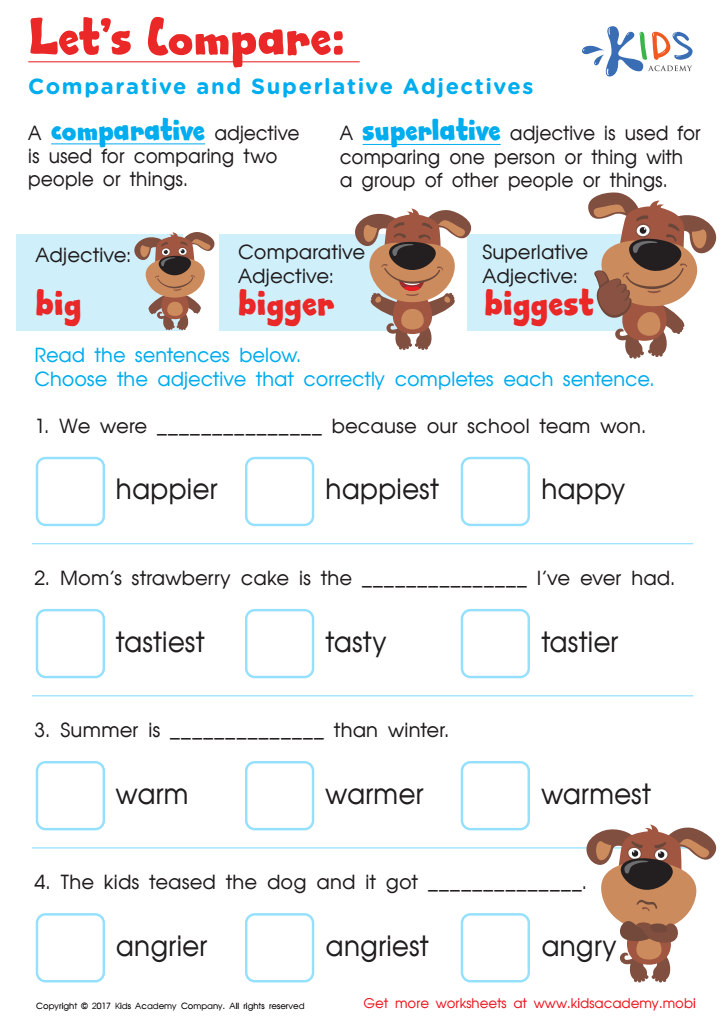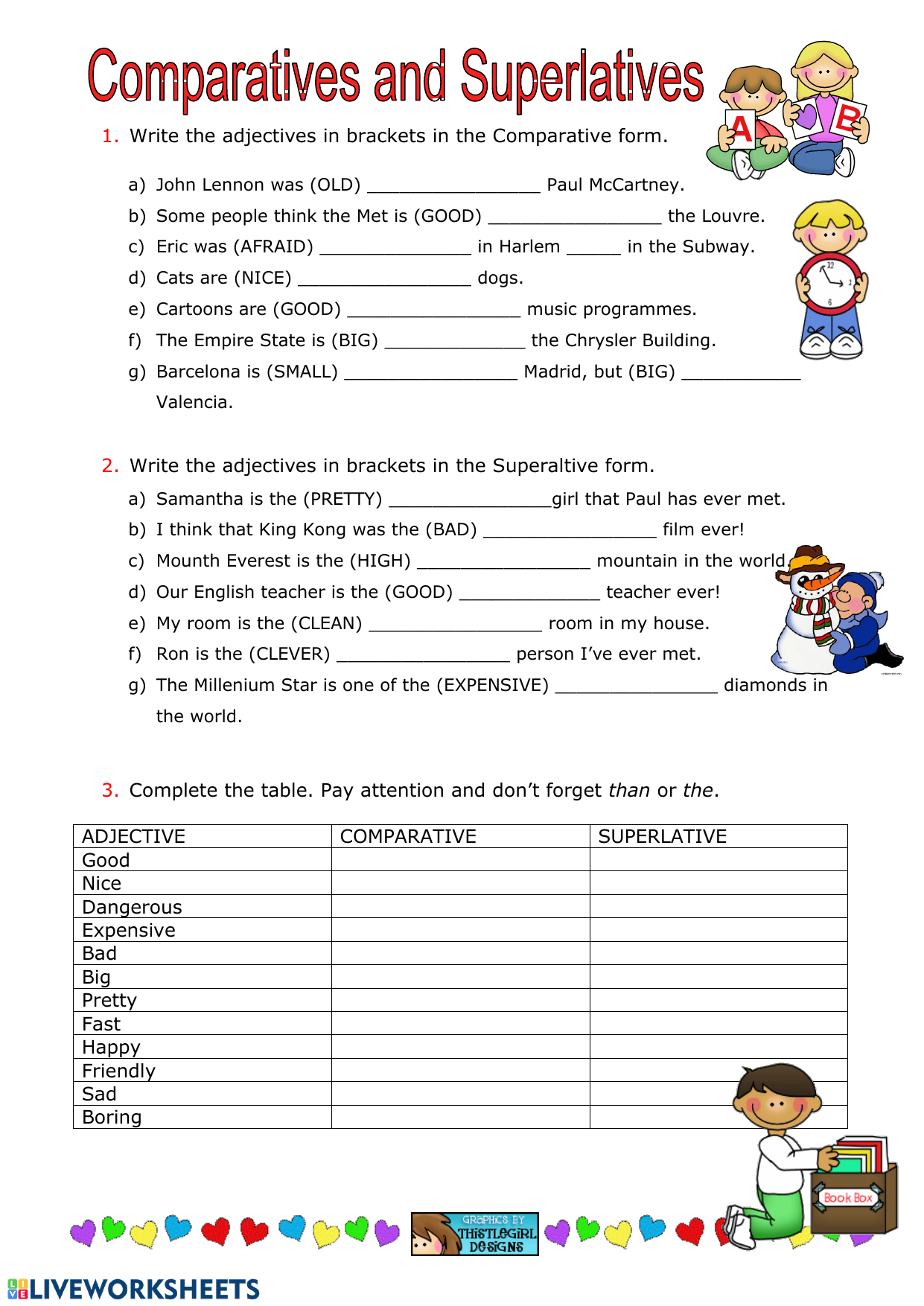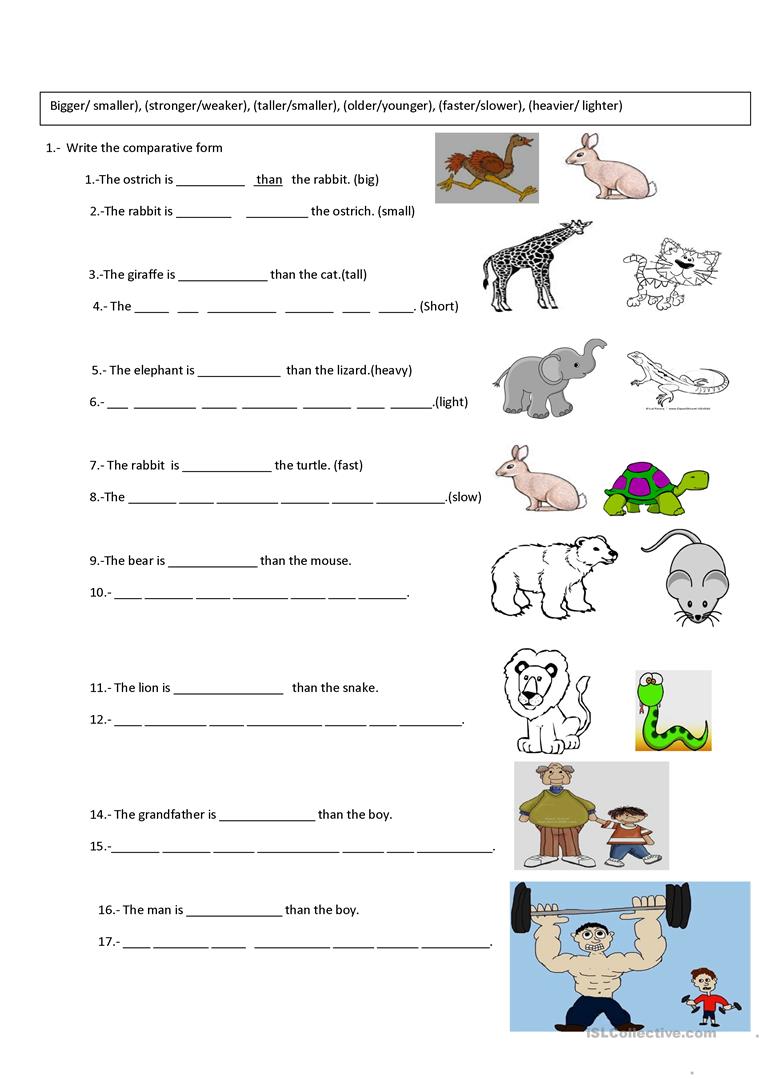
Mastering Degrees: The Essential Role of Comparative and Superlative for Primary Worksheets
In the realm of English language acquisition, teaching children how to describe and compare is fundamental to their ability to express themselves clearly and effectively. From describing the tallest building to comparing the speed of two animals, comparative and superlative adjectives are indispensable tools in a young learner’s linguistic toolkit. However, grasping these grammatical concepts can often be challenging for primary school students, who are still developing their understanding of word forms and sentence structures. This is where the strategic use of comparative and superlative for primary worksheets becomes an invaluable asset for educators and parents alike.
This article will delve into the importance of comparatives and superlatives, explore the rules governing their formation, and highlight why well-designed worksheets are crucial for effective learning at the primary level. We will also discuss various types of activities found in these worksheets and provide insights into how to choose and utilize them for maximum impact.

Understanding Comparatives and Superlatives: The Building Blocks of Comparison

Before diving into the specifics of worksheets, let’s establish a clear understanding of what comparative and superlative adjectives are and why they matter.

Comparative Adjectives are used when we want to compare two nouns or pronouns. They show which of the two items has more of a certain quality. We often use the word "than" after a comparative adjective.

- Example: My dog is bigger than your cat. (Comparing two animals)
- Example: This book is more interesting than that movie. (Comparing two entertainment forms)

Superlative Adjectives are used when we want to compare three or more nouns or pronouns. They indicate which item has the most or least of a certain quality within a group. We typically use "the" before a superlative adjective.
- Example: Mount Everest is the highest mountain in the world. (Comparing one mountain to all others)
- Example: She is the most intelligent student in the class. (Comparing one student to all others in the group)


The ability to use these forms correctly allows children to paint more vivid pictures with their words, express preferences, and articulate observations with greater precision. Without them, their descriptive language would be limited to simple statements, hindering their communication skills.

The Rules of Formation: A Step-by-Step Guide for Young Learners
One of the primary challenges in teaching comparatives and superlatives is the variety of rules for their formation. These rules depend largely on the number of syllables in the adjective. Comparative and superlative for primary worksheets often break down these rules into manageable chunks, providing ample practice for each category.

1. One-Syllable Adjectives: Simple Additions
For most one-syllable adjectives, we simply add "-er" for the comparative form and "-est" for the superlative form.
- Positive: tall
- Comparative: taller
- Superlative: tallest
- Positive: short
- Comparative: shorter
- Superlative: shortest
- Positive: fast
- Comparative: faster
- Superlative: fastest
Spelling Rules for One-Syllable Adjectives:
- Ending in -e: If the adjective ends in ‘e’, just add ‘-r’ or ‘-st’.
- nice -> nicer -> nicest
- large -> larger -> largest
- Ending in CVC (Consonant-Vowel-Consonant): Double the final consonant before adding ‘-er’ or ‘-est’.
- big -> bigger -> biggest
- hot -> hotter -> hottest
- sad -> sadder -> saddest
2. Two-Syllable Adjectives: A Split Path
Two-syllable adjectives can be a bit trickier, as they follow one of two patterns:
- Ending in -y: If the adjective ends in ‘-y’, change the ‘y’ to ‘i’ and then add ‘-er’ or ‘-est’.
- happy -> happier -> happiest
- funny -> funnier -> funniest
- easy -> easier -> easiest
- Not ending in -y: For most other two-syllable adjectives (and all adjectives with three or more syllables), we use "more" for the comparative and "most" for the superlative.
- careful -> more careful -> most careful
- modern -> more modern -> most modern
- boring -> more boring -> most boring
3. Three or More Syllable Adjectives: Always "More" and "Most"
Adjectives with three or more syllables consistently use "more" for the comparative and "most" for the superlative.
- Positive: beautiful
- Comparative: more beautiful
- Superlative: most beautiful
- Positive: important
- Comparative: more important
- Superlative: most important
- Positive: expensive
- Comparative: more expensive
- Superlative: most expensive
4. Irregular Adjectives: The Exceptions to the Rule
Every language has its quirks, and English is no exception. Some common adjectives have irregular comparative and superlative forms that simply need to be memorized.
- good -> better -> best
- bad -> worse -> worst
- far -> farther/further -> farthest/furthest
- little (amount) -> less -> least
- much/many -> more -> most
Teaching these rules systematically, with clear examples and repeated practice, is paramount. This is precisely where comparative and superlative for primary worksheets shine.
The Power of Primary Worksheets: Why They Are So Effective
The beauty of comparative and superlative for primary worksheets lies in their structured approach to learning, offering numerous benefits for young students:
- Structured Practice: Worksheets provide a systematic way for students to practice the rules they’ve learned. They can focus on one rule at a time (e.g., only one-syllable adjectives) before moving on to more complex patterns.
- Reinforcement and Repetition: Repetition is key to mastering grammar. Worksheets offer multiple opportunities to apply the rules, solidifying understanding and aiding memorization.
- Visual Learning: Many primary worksheets incorporate engaging illustrations and clear layouts, which are highly appealing and helpful for visual learners. Pictures can provide context for the adjectives, making the concepts more tangible.
- Active Learning: Unlike passive listening, completing a worksheet requires active participation. Students must think about the rules and apply them to specific examples.
- Immediate Feedback (with Answer Keys): When worksheets come with answer keys, students (or parents/teachers) can quickly check their work, identifying mistakes and learning from them immediately.
- Varied Activities: Good worksheets don’t just ask students to fill in blanks. They offer a range of activities that keep learning engaging and cater to different learning styles.
Types of Activities Found in Effective Worksheets
To truly make a difference, comparative and superlative for primary worksheets should offer a diverse set of exercises. Here are some common and effective types:
- Fill-in-the-Blanks: Students complete sentences by choosing the correct comparative or superlative form of a given adjective.
- Example: My sister is (old) ___ than me. (older)
- Example: The elephant is (big) ___ animal in the jungle. (the biggest)
- Sentence Completion: Students are given a scenario and must write a sentence using a comparative or superlative adjective.
- Example: Apples are healthy, but oranges are (healthy). -> Oranges are healthier than apples.
- Picture Matching/Description: Students match pictures to sentences using comparative/superlative forms or describe what they see using these adjectives.
- Example: Picture of a small mouse and a large elephant. -> The elephant is larger than the mouse.
- Choose the Correct Word: Students select the appropriate comparative or superlative from a multiple-choice list.
- Example: This is (the good / the better / the best) pizza I’ve ever eaten! (the best)
- Error Correction: Students identify and correct mistakes in sentences that misuse comparative or superlative forms. This encourages critical thinking.
- Creating Sentences/Short Stories: More advanced worksheets might ask students to write their own sentences or a short paragraph using a list of adjectives in their comparative and superlative forms.
- Categorization: Students sort adjectives into categories based on how their comparative/superlative forms are made (e.g., add -er/-est, use more/most, irregular).
Designing and Choosing Effective Worksheets
When selecting or creating comparative and superlative for primary worksheets, consider the following:
- Clarity and Simplicity: The instructions should be easy for a primary student to understand. The layout should be clean and uncluttered.
- Gradual Progression: Start with the simplest rules (one-syllable adjectives) and gradually introduce more complex ones, including irregular forms.
- Age Appropriateness: The vocabulary and sentence structures used should be suitable for the target age group.
- Engaging Content: Use relatable examples (animals, toys, family members) and bright, appealing visuals.
- Real-World Context: Whenever possible, put the exercises into a context that makes sense to children (e.g., comparing heights of friends, sizes of fruits).
- Differentiation: Look for worksheets that offer different levels of difficulty, allowing for differentiation within a classroom or for individualized learning at home.
- Answer Keys: These are invaluable for self-correction and for parents/teachers who may not be grammar experts themselves.
Integrating Worksheets into a Broader Learning Strategy
While comparative and superlative for primary worksheets are incredibly effective, they should not be the sole method of instruction. For holistic language development, integrate them with other activities:
- Oral Practice: Encourage students to use comparatives and superlatives in conversations. Ask questions like, "Which animal is faster, a rabbit or a turtle?" or "Who is the tallest person in our family?"
- Games: Play simple games like "I Spy" using comparative adjectives ("I spy something redder than your shirt") or charades where students act out adjectives to be compared.
- Reading: Point out comparative and superlative adjectives in storybooks or simple non-fiction texts. Discuss why the author chose those specific words.
- Writing: Encourage students to incorporate comparatives and superlatives into their creative writing or descriptive essays.
- Real-Life Application: Use everyday situations to practice. "Which apple is bigger?" "Who has more toys?" "This soup is warmer than that one."
Conclusion
The journey to mastering comparatives and superlatives is a significant step in a primary student’s English language development. These grammatical forms empower children to express nuanced observations, make detailed comparisons, and communicate more effectively. Ultimately, the journey to mastering comparatives and superlatives is made significantly smoother and more enjoyable with the right resources, and comparative and superlative for primary worksheets are undoubtedly among the most effective tools in a primary educator’s arsenal.
By providing structured, engaging, and repetitive practice, these worksheets help cement complex grammatical rules into young minds, transforming abstract concepts into practical language skills. Embracing well-designed comparative and superlative for primary worksheets is a crucial step towards building a strong linguistic foundation for young learners, enabling them to confidently navigate the descriptive richness of the English language.
